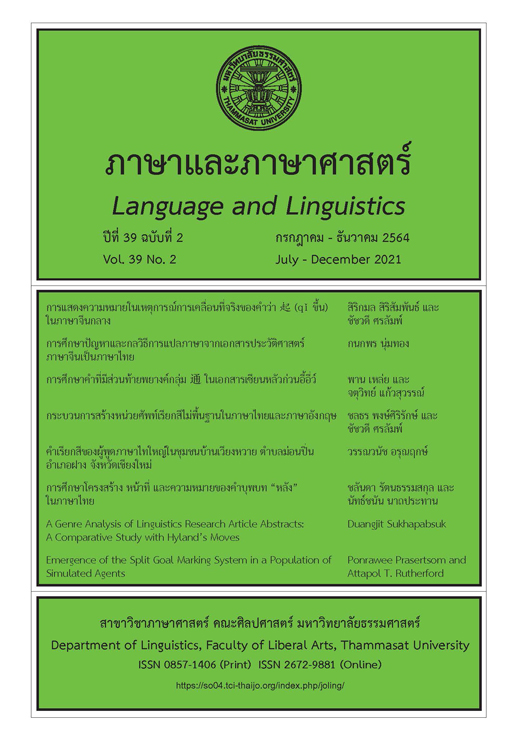The Meanings of QI in Mandarin Chinese in Factive Motion Events
Main Article Content
Abstract
QI in Mandarin Chinese is polysemous. Its meanings deal with human bodily experiences of motion, and motions of objects, as well as human conceptions of time and quantity. This research aims to analyze the meanings of QI in factive motion events. The method was to obtain 1,945 sentences from three corpora in which the word QI is used: the Mandarin Chinese Corpus of the Center for Chinese Linguistics, Peking University; the Mandarin Chinese Corpus of the Beijing Language and Culture University; and the Chinese Corpus of the Chinese Ministry of Education. The findings show five meanings of QI in factive motion events. The meanings are 1) self-agentive changing posture MOVE with the PATH, 2) self-agentive/agentive transitional MOVE with the PATH, 3) the PATH of change of posture, 4) the PATH of transitional move, and 5) the PATH of bodily internal move. All of them include the meaning of PATH as a straight vertical line with departure vector where FIGURE is above GROUND with anchorage attention.
Article Details
บทความทุกบทความเป็นลิขสิทธิ์ของภาษาและภาษาศาสตร์
References
Beijing Language and Culture University Corpus 汉语语料库. Retrieved January 19, 2019, from http://www.bcc.blcu.edu.cn
Center for Chinese Linguistics Corpus 北京大学语料库. Retrieved August 31, 2018, from http://www.ccl.pku.edu.cn
Chu, Chengzhi. (2004). Event conceptualization and grammatical realization: The case of motion in Mandarin Chinese [Unpublished doctoral dissertation]. University of Hawai’i.
Dictionary Editorial Office of Language Institute, Chinese Academy of Social Science 中国社会科学院语言研究所词典编辑室 (2016). 现代汉语词典 第7版.. 商务印书馆.
Evans, V., & Green, M. (2006). Cognitive linguistics: An introduction. Edinburgh University Press.
Langacker, R. W. (2008). Cognitive grammar: A basic introduction. Oxford University Press.
Talmy, L. (2000). Toward a cognitive semantics, volume 1: Concept structuring system. The MIT Press.
Xiao Hang 肖航. (n.d.). 语料库在线. Retrieved May 5, 2019, from http://www.cncorpus.org/resources.aspx


